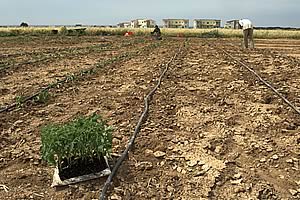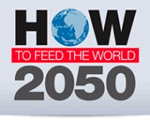2009-09-28
Producing more food will largely depend on increasing crop yields, not farming more land.
Boosting agricultural production to the levels needed to feed an expanded world population will require sharply increased public investment in research and development and widespread adoption of new technologies, farming techniques and crop varieties, according to a new FAO discussion paper published this week.
The paper, titled "The Technology Challenge," is one of several produced by the UN food agency to serve as starting points for panel discussions at the "High-Level Expert Forum on How to Feed the World in 2050," taking place at FAO's Rome headquarters October 12-13. The Forum will prepare the ground for the World Summit on Food Security from 16 to 18 November 2009.
FAO's latest projections indicate that global agricultural production must grow by 70 percent by 2050 in order to feed an additional 2.3 billion people.
The projections indicate that most gains in production will be achieved by increasing yield growth and cropping intensity on existing farmlands rather than by increasing the amount of land brought under agricultural production.
Globally, 90 percent of required production increases are projected to come from augmenting yields and cropping intensity, and only 10 percent by expanding arable land. For developing countries, FAO estimates that ratio at 80/20. But in land-scarce countries, almost all growth would need to be achieved by improving yields.
This necessitates "pushing the agricultural technology frontier outwards" on a number of fronts, the paper says.
Climate change, water scarcity, post-harvest losses
The challenge of boosting crop yields is made more pressing by climate change.
If temperatures rise by more than 2oC, global food production potential is expected to contract severely and yields of major crops like maize may fall. The declines will be particularly pronounced in lower-latitude regions - in Africa, Asia and Latin America, yields could drop by between 20-40 percent if effective adaptation measures are not taken.
New technologies and improved practices will therefore also be needed to deal with a changing climate - as well as with rapidly increasing water scarcity, the paper says.
Raising agricultural productivity by reducing post-harvest losses is another area where innovations are necessary.
Priority areas for action
According to the paper, there are several areas where enhanced farming techniques and new technologies could be tapped to boost production:
• Improving efficiency in farmers' use of agricultural inputs. This will become increasingly important as natural resources get scarcer and prices of resources such as fossil fuels, nitrogen and phosphorus increase.
One technique that offers promise in this regard is conservation agriculture using zero tillage - farms employing this technique reduce their fuel use by an average of two-thirds while simultaneously raising levels of soil carbon sequestration.
The paper also says that fertilizers will need to be used more efficiently through greater on-farm use of nitrogen and increasing supplies of biologically-fixed nitrogen.
Water is another resource that must be used more efficiently, through practices such as water harvesting and conservation of soil moisture.
• Developing improved crop varieties. Plant breeding techniques can lead to improved crop varieties that increase yields, decrease losses, and make agriculture more resistant to climate-associated stresses and water scarcity. However FAO's discussion paper also notes the need to evaluate new technologies carefully to avoid possible negative environmental and human-health impacts.
• Heavily investing in agricultural research and development. Noting that investment in R&D is the most productive way to support agriculture, the paper argues that "massive public and private investments in R&D are required if agriculture is to benefit from the use of new technologies and techniques". The need for substantially higher levels of investment in agriculture R&D will further increase due to climate change and intensifying water scarcity, it adds.
• Closing existing "yield gaps". Even as new technologies are explored, one area where progress is needed is promoting greater adoption of existing advances. Many farms today produce less food than they are capable of simply because they do not make use of enhanced seeds and cropping techniques that are currently available. Reasons for this include a lack of financial incentives, poor access to information, weak extension services, and insufficient opportunities for acquiring the necessary technical skills.
Expert forum
During the "High-Level Expert Forum on How to Feed the World in 2050," top people working in the areas of agriculture, rural development, food security and hunger will be joining with FAO experts to tackle various questions related to what will be required to feed an expanded world population by the year 2050.
 Kathryn Potts Appointed NEEFM Manager Kathryn Potts Appointed NEEFM Manager
 Malvern Autumn Show is a Real Feast! Malvern Autumn Show is a Real Feast!
 Windfall for Farmers Markets Windfall for Farmers Markets
|



